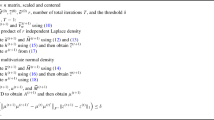Abstract
Sparse principal component analysis (SPCA) has achieved great success in improving interpretable ability of the derived results and has become a powerful technique for modern data analysis. It presents that principal component can be modified to produce sparse loadings by imposing sparsity-induced penalty, which is often \(l_{1}\)-regularized constraint. In order to analyze the \(l_{1}\)-regularized sparsity-induced model, in this paper, we propose a general null space property of a matrix \(\mathbf {A}\) relative to a index set S and give a necessary and sufficient condition for the exact or approximate sparse principal components. Meanwhile, the conclusions with respect to the stable and robust situations are given in the case of exact or approximate sparse principal components, respectively.
Similar content being viewed by others
Data Availability Statement
Data sharing not applicable to this article as no datasets were generated or analyzed during the current study.
References
I.T. Jolliffe, Principal Component Analysis, 2nd edn. (Springer, New York, 2002)
S. Gajjar, M. Kulahci, A. Palazoglu, Use of sparse principal component analysis (SPCA) for fault detection. IFAC-PapersOnLine 49(7), 693–698 (2016)
A. D’Aspremont, F. Bach, L.E. Ghaoui, Optimal solutions for sparse principal component analysis. J. Mach. Learn. Res. 9, 1269–1294 (2008)
K. Fang, X. Fan, Q. Zhang, S. Ma, Integrative sparse principal component analysis. J. Multivar. Anal. 166, 1–16 (2018)
I.T. Jolliffe, N.T. Trendafilov, M. Uddin, A modified principal component technique based on the lasso. J. Comput. Graph. Stat. 12(3), 531–547 (2003)
A. D’Aspremont, L.E. Ghaoui, M.I. Jordan, G.R.G. Lanckriet, A direct formulation for sparse PCA using semidefinite programming. SIAM Rev. 49(3), 434–448 (2007)
H. Shen, J.Z. Huang, Sparse principal component analysis via regularized low rank matrix approximation. J. Multivar. Anal. 99(6), 1015–1034 (2008)
M. Journée, Y. Nesterov, P. Richtrik, R. Sepulchre, Generalized power method for sparse principal component analysis. Core Discuss. Pap. 11(2008070), 517–553 (2010)
C. Sigg, J.M. Buhmann, Expectation-maximization for sparse and non-negative PCA, in Proceedings of 25th International Conference on Machine Learning (ICML), ACM, 960–967 (2008)
H. Zou, T. Hastie, Regularization and variable selection via the elastic net. J. R. Stat. Soc. 67(2), 301–320 (2005)
H. Zou, T. Hastie, R. Tibshirani, Sparse principal component analysis. J. Comput. Graph. Stat. 15, 265–286 (2004)
S. Foucart, H. Rauhut, A Mathematical Introduction to Compressive Sensing (Springer, New York, 2013)
S.S. Chen, D.L. Donoho, M.A. Saunders, Atomic decomposition by basis pursuit. SIAM Rev. 43(1), 129–159 (2001)
Acknowledgements
The authors would like to thank the anonymous reviewers and the associate editor and editor-in-chief for their constructive suggestions, which improve the manuscript significantly. This work was supported by the National Natural Science Foundation of China under the Grants No. 11771347, 91730306, 41390454.
Author information
Authors and Affiliations
Corresponding author
Ethics declarations
Conflict of interest
The authors declare that there are no known conflicts of interest associated with this publication.
Additional information
Publisher's Note
Springer Nature remains neutral with regard to jurisdictional claims in published maps and institutional affiliations.
Rights and permissions
About this article
Cite this article
Han, X., Peng, J., Cui, A. et al. A General Null Space Property for Sparse Principal Component Analysis. Circuits Syst Signal Process 41, 4570–4580 (2022). https://doi.org/10.1007/s00034-022-01991-y
Received:
Revised:
Accepted:
Published:
Issue Date:
DOI: https://doi.org/10.1007/s00034-022-01991-y




